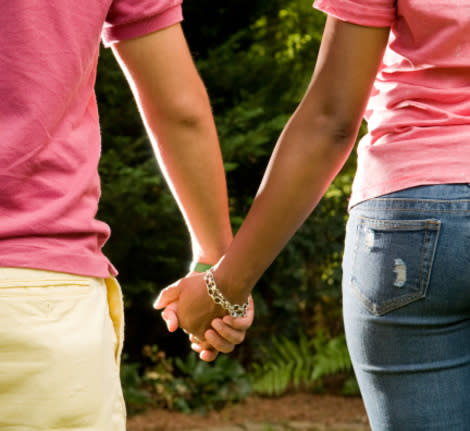Interracial Marriage Hits All-time High

Interracial marriage in the United States has hit an all-time high, a new study suggests, with a record 1 in 12 marriages taking place between people from different racial backgrounds.
"The rise in interracial marriage indicates that race relations have improved over the past quarter century," Daniel Lichter, a sociology professor at Cornell University, told The Associated Press. "Mixed-race children have blurred America's color line. They often interact with others on either side of the racial divide and frequently serve as brokers between friends and family members of different racial backgrounds."
Related: Would you date outside your race? The differences between men and women
But America still has a long way to go. Less than six months ago, a Kentucky church voted to ban interracial marriages and prevent mixed-race couples from becoming members (the congregation later voted to overturn the ban). Anti-miscegenation laws criminalizing interracial marriage were on the books in many states until 1967; Alabama did not officially lift its ban until 2000. And in April 2011, a Public Policy Polling survey found that 46 percent of Republicans in Mississippi still think interracial marriage should be illegal.
According to a Pew Research Center study that was released on Thursday, 8.4 percent of U.S. marriages are interracial, up from 3.2 percent in 1980. Out of marriages performed in 2010, 15 percent were interracial. The study relied on U.S. Census data and information from the American Community Surveys taken from 2008 to 2010.
While ethnicity and race are two different things, for survey and census purposes they are often used interchangeably. In the Pew study, the term "white" referred to Caucasians who did not also identify as Hispanic.
The study found that Hispanics and Asians were still most likely to marry someone from a different racial background, but the biggest change took place among African Americans, where interracial marriages increased from 15.5 percent to 17.1 percent. Black men were nearly three times as likely as black women to marry someone of a different race, 24 percent to 9 percent.
Just 17 percent Asian men, on the other hand, married someone of a different race during that time, compared to 36 percent among Asian women. Intermarriage rates among Hispanics was about 25.7 percent, and among whites it was 9.4 percent. Of the 275,700 new interracial marriages in 2010, 43 percent were whites marrying Hispanics, 14.4 percent were whites marrying Asians, and 11.9 percent were white marrying blacks.
Interracial marriages are more prevalent in some parts of the United States than in others. Hawaii was most likely to have mixed-race couples, with 42 percent of marriages from 2008 to 2010 involving people of different races. Other Western states -- including California, Nevada, and New Mexico -- and those in the Northeast were most likely to say such marriages are beneficial for society. Vermont, however, had the lowest rate of intermarriage -- just 4 percent.
Overall, the public perception of mixed marriages has only grown more positive. About 83 percent of Americans now say they think it's "all right" for blacks and whites to date one another; in 1987, only 48 percent of respondents agreed with the idea. Sixty-three percent now say it "would be fine" if a family member married someone from another race, and 61 percent of 18- to 29-year-olds said that they felt interracial marriages were changing society "for the better." (Twenty-eight percent of respondents age 65 or older agreed.) According to the study, minorities, young adults, college-educated adults, and those who identify as "liberal" were most likely to look at interracial marriage in a positive way.
Thanks to such unions, the number of multiracial Americans is also on the rise. About 9 million people -- roughly 8 percent of the minority population in the United States -- identify as multiracial.
"Race is a social construct; race isn't real," Jonathan Brent, whose father is white and his mother is Japanese-American, told the Associated Press. It's an idea that more and more young adults agree about.
"In the past century, intermarriage has evolved from being illegal, to be a taboo and then to be merely unusual. And with each passing year, it becomes less unusual," Paul Taylor, director of Pew's Social & Demographic Trends project, told the Associated Press. "For younger Americans, racial and ethnic diversity are a part of their lives."
Copyright © 2012 Yahoo Inc.
Also on Shine:
The Loving family: Tender photos from a turbulent time
Kentucky church bands interracial couples from becoming members
Is interracial dating still taboo?
